We strive to make our funeral home feel like a second home to our families.
Our facility has the features to give your family the best services possible, and we hope that it brings you comfort during your time of need.





















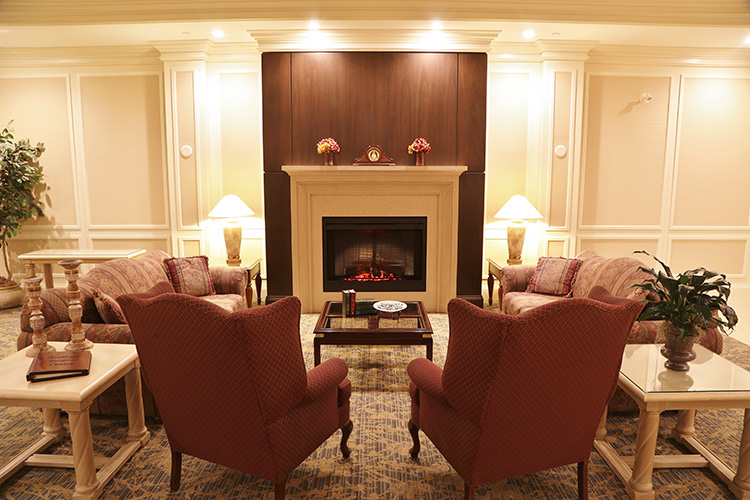
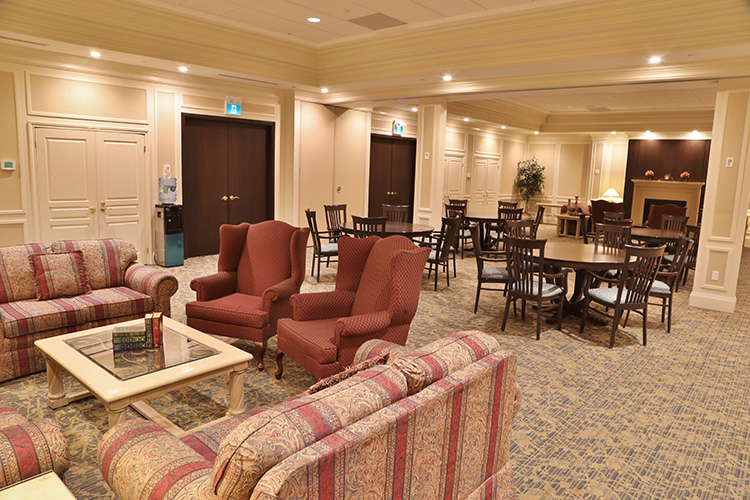
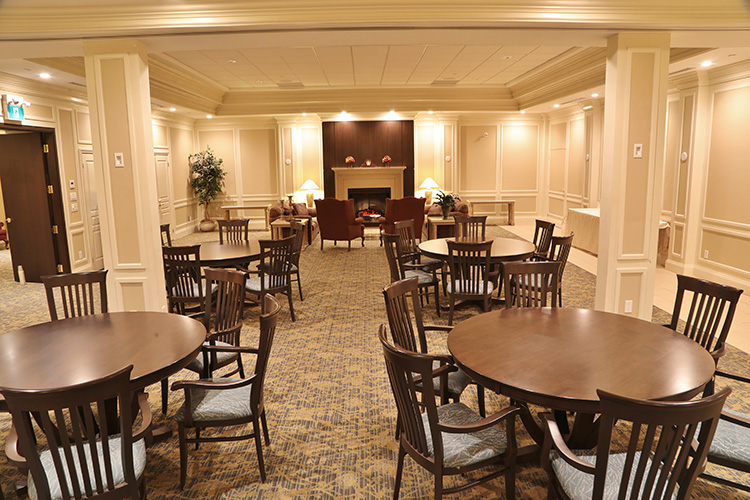
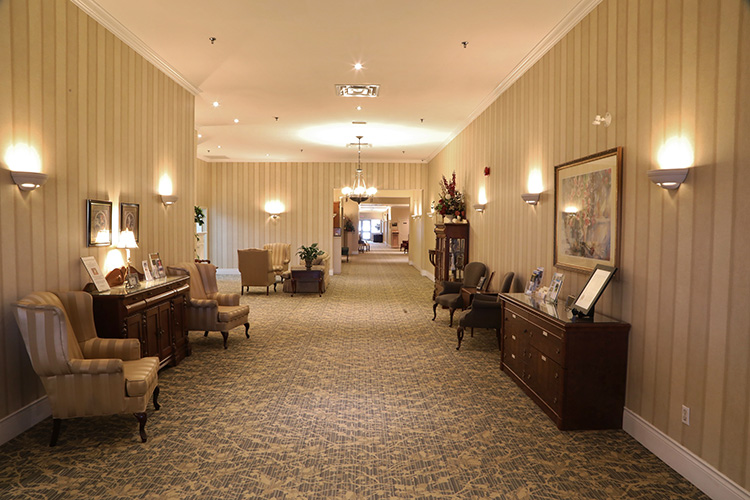
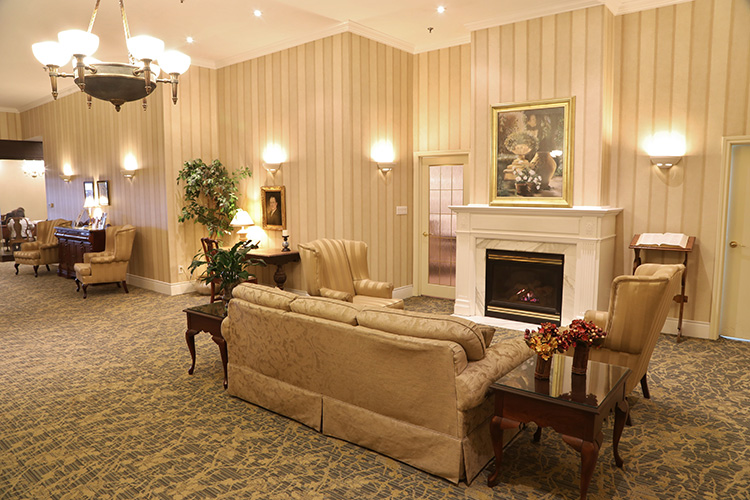
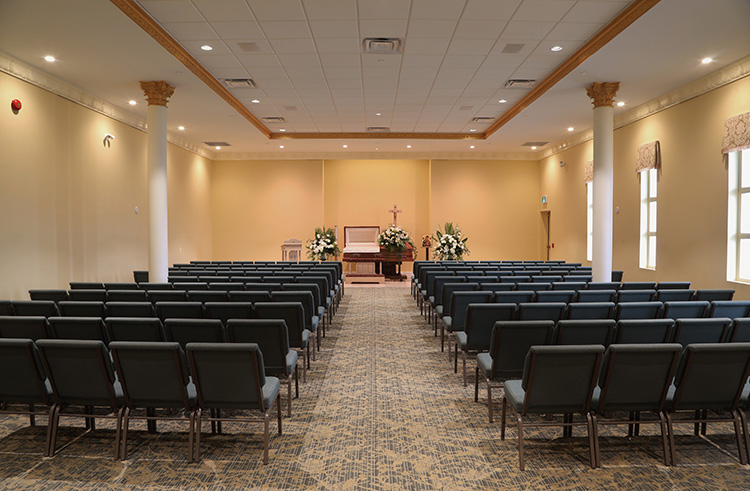
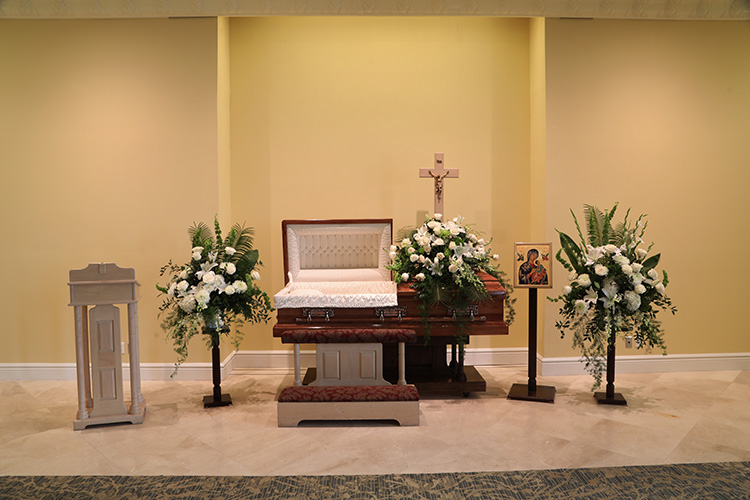
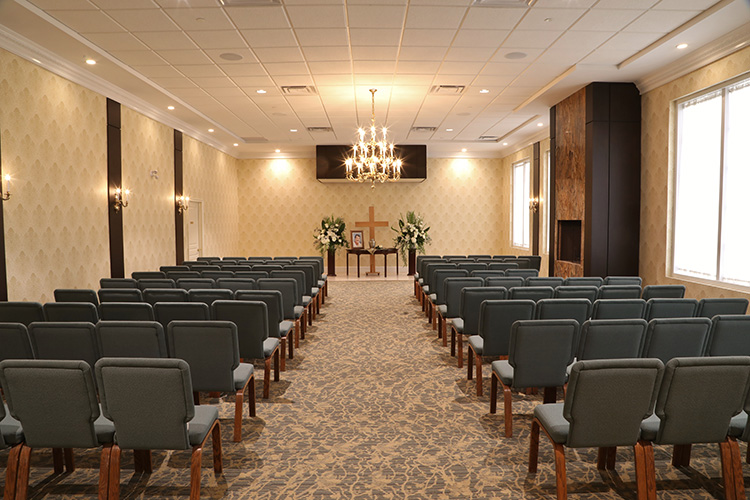
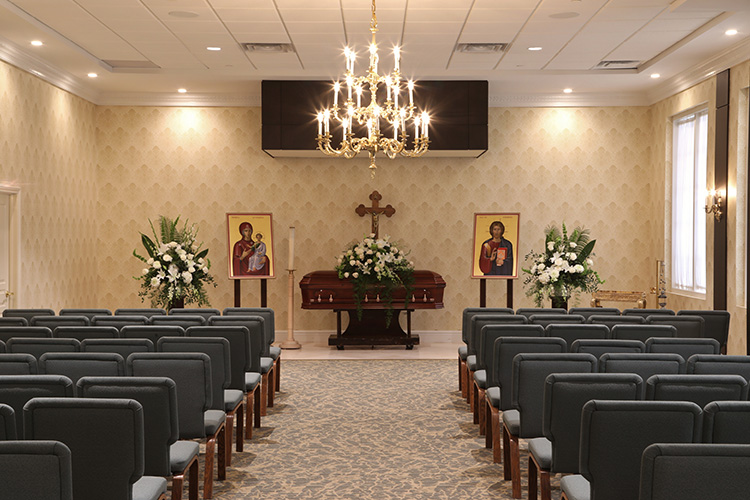
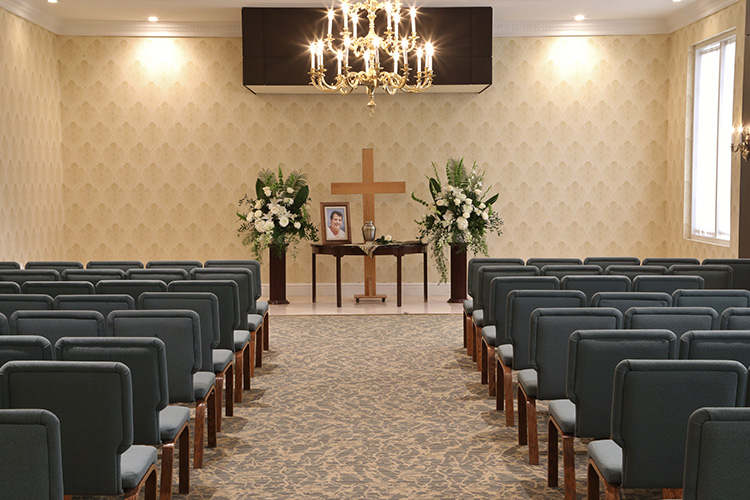
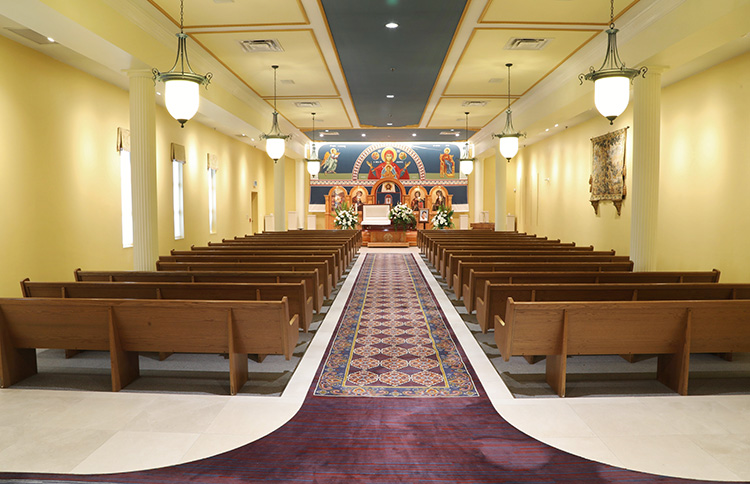
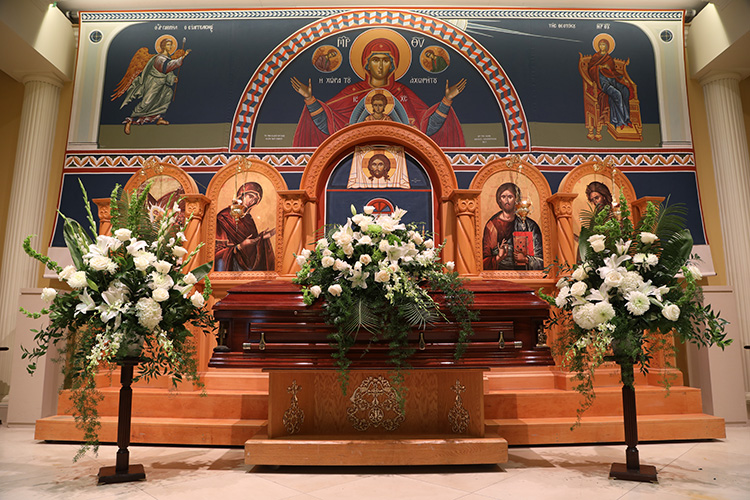
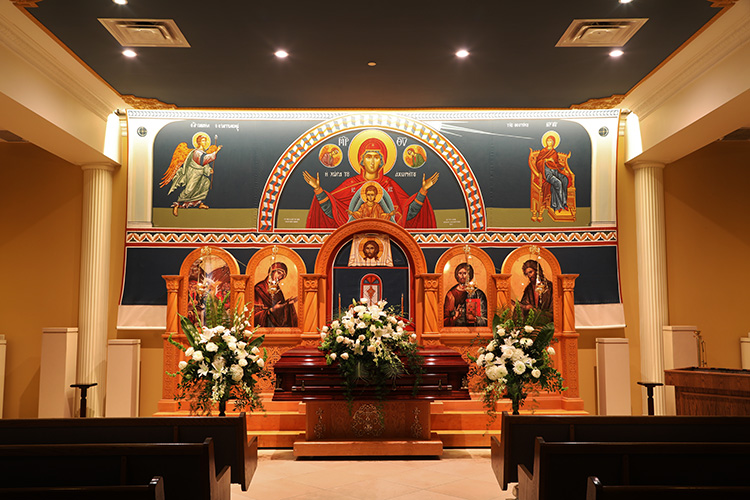
The O’Connor Bros. Chapel
 You may decide on our recently renovated O’Connor Bros. chapel. This chapel is a favourite for a diversity of clients. It can aesthetically serve families in numerous ways. It also allows for a large number of gatherings, as it is our second largest chapel option in the funeral home. It has a fantastic sound system able to play virtually anything the internet has to offer or your own audio file. As an option, professionally produced live-streaming can be selected.
You may decide on our recently renovated O’Connor Bros. chapel. This chapel is a favourite for a diversity of clients. It can aesthetically serve families in numerous ways. It also allows for a large number of gatherings, as it is our second largest chapel option in the funeral home. It has a fantastic sound system able to play virtually anything the internet has to offer or your own audio file. As an option, professionally produced live-streaming can be selected.
History
 The chapel is named after the former O’Connor Bros. Funeral Home on Danforth Ave. that was opened by the late Frank and the late Vincent O’Connor, in 1923. That funeral home closed in 2009. This chapel is dedicated to their memory and to honour the service of their family-run funeral home which served numerous members of the east-end Toronto community over its 86 years of existence on the Danforth. The chapel was dedicated in 2009.
The chapel is named after the former O’Connor Bros. Funeral Home on Danforth Ave. that was opened by the late Frank and the late Vincent O’Connor, in 1923. That funeral home closed in 2009. This chapel is dedicated to their memory and to honour the service of their family-run funeral home which served numerous members of the east-end Toronto community over its 86 years of existence on the Danforth. The chapel was dedicated in 2009.
Artwork
![]() This chapel is unique insofar as artwork goes. Recent renovations and new installments have included sliding walls which act as backdrops for visitations and services. This addition allows families different options as to how they would like to personalize the room to their traditions, faiths or tastes. As such, it renders the chapel “chameleon-like”, given its many capabilities. In particular, there are four different options to choose from.
This chapel is unique insofar as artwork goes. Recent renovations and new installments have included sliding walls which act as backdrops for visitations and services. This addition allows families different options as to how they would like to personalize the room to their traditions, faiths or tastes. As such, it renders the chapel “chameleon-like”, given its many capabilities. In particular, there are four different options to choose from.
The Blank Wall
The blank wall can be anything that anyone wants or needs it to be. It can act as an open canvas for whatever personalization is desired or deemed suitable, or it can act as a simpler setting for those with simpler tastes. It may, for example, be used to hang and display a portrait of your loved one resting in this chapel, or perhaps even one or several family photos.
Stained Glass, Christ Among the Lilies
 This is a piece that was acquired from a collector in Salt Lake City, Utah who had rescued it from demolition of a church in Pennsylvania. It depicts Jesus Christ, surrounded by many elements representing life, death and the afterlife.
This is a piece that was acquired from a collector in Salt Lake City, Utah who had rescued it from demolition of a church in Pennsylvania. It depicts Jesus Christ, surrounded by many elements representing life, death and the afterlife.
The central figure of Christ appears extending his welcoming hands outwards, a common theme in Christian art. Perhaps this could be interpreted as Christ either opening his arms to us for an embrace, or wishing to show us what lies before us (especially so in the context of this piece and its rich symbolism). This particular image gives us several different symbols to draw our attention.
At the very bottom, around Christ’s feet, the earth seems rather bleak and dull. If one looks closely, you may notice only minimal growth; perhaps mere weeds. Christ often uses bad soil and weeds in parables to represent death and lost souls (see Matthew 13:18-23). This is immediately contrasted, though, with the bright and colourful lilies that are growing right above. Lilies, too, are specifically used by Christ allegorically, but for life and blessedness; an invitation to trust in him and not to fear.
 “Therefore I tell you, do not worry about your life … Consider the lilies of the field, how they grow; they neither toil nor spin, yet I tell you, even Solomon in all his glory was not clothed like one of these.”
“Therefore I tell you, do not worry about your life … Consider the lilies of the field, how they grow; they neither toil nor spin, yet I tell you, even Solomon in all his glory was not clothed like one of these.”
Matthew 6:25-29
“My beloved has gone down to his garden, to the beds of spices, to pasture his flock in the gardens, and to gather lilies. I am my beloved’s and my beloved is mine; he pastures his flock among the lilies.”
Song of Solomon 6:2-3
“I will be like the dew to Israel; he shall blossom like the lily, he shall strike root like the forests of Lebanon.”
Hosea 14:5
 Further upwards we find a city skyline, a panorama view. This can represent many things, among which could be the City of Jerusalem in its temporal sense, as the place where Christ was crucified, died, buried and resurrected. But given its surrounding aura of splendor, it could very likely depict the New Jerusalem, the Heavenly Jerusalem: the name which Sacred Scripture gives for Paradise and the coming of future glory (see Revelation 2:1-3). Continuing on that same idea, the skyline could represent the many dwellings of Heaven promised by Christ to those who follow him (see John 14:1-3).
Further upwards we find a city skyline, a panorama view. This can represent many things, among which could be the City of Jerusalem in its temporal sense, as the place where Christ was crucified, died, buried and resurrected. But given its surrounding aura of splendor, it could very likely depict the New Jerusalem, the Heavenly Jerusalem: the name which Sacred Scripture gives for Paradise and the coming of future glory (see Revelation 2:1-3). Continuing on that same idea, the skyline could represent the many dwellings of Heaven promised by Christ to those who follow him (see John 14:1-3).
Finally, the top window ornamentation invites us to think about life as if we were looking at a picture, or through a window. This detail adds some perspective; not only is it a traditional artistic element to stained glass pieces, but it adds an analytical element to the whole “framework”, so to speak, of the image of Christ, surrounded by all that which points to life and death around him.
The stained glass, Christ Among the Lilies, is a suitable option for any professing Christian, notwithstanding denomination or tradition. But as the imagery in the piece suggests, this option remains open to anyone and everyone who desires it.
Christian Icon, Christ’s Descent into Hades
![]() Heritage commissioned this original work with the great assistance of Very Reverend Father Ilija Dimitrieski. It is a rendition of the famous icon of the Mystery of Christ’s Resurrection from His Descent into Hades. This option is customary to the Orthodox faith for visitations and services involving their loved ones, but it can also serve the needs of any who request it.
Heritage commissioned this original work with the great assistance of Very Reverend Father Ilija Dimitrieski. It is a rendition of the famous icon of the Mystery of Christ’s Resurrection from His Descent into Hades. This option is customary to the Orthodox faith for visitations and services involving their loved ones, but it can also serve the needs of any who request it.
This icon represents the Mystery of Christ’s Resurrection, following His Descent into Hades after his death on the cross. This Mystery involves His rescuing and bringing up with Him into heaven all the righteous who had died before his own death; all those from Adam and Eve down to the repentant thief (cf. Luke 23:43).
The figures in this icon, as well as the very basis for their inclusion in it, are all very rich in symbolism. Let us begin with the most predominant of them all: Christ himself, found in the central mandorla (a common element in iconography; symbolizes Christ’s majesty): the focal point of the entire icon. This depicts Christ in glory, who has just “accomplished” His mission on earth (see John 19:30). Now we see Him ascending from Hades (or Hell), freeing with Him those who fell asleep before his crucifixion and death. These people are represented by the Old Testament figures who encircle Christ throughout the icon.
To the left of Christ are figures with halos (or aura around their heads). They are: St. King David (crowned, with white beard), his son St. King Solomon (crowned, beardless), and St. John the Baptist (with brown beard), the precursor of Christ. These figures are here because of their importance in precursing Christ in the Scriptures.
The figures emerging from their tombs are Adam and Eve, respectively. They represent all of humanity, who, despite sin, might find God and have eternal life if they so choose. Typically, Adam and Eve are depicted as young and full of life, since they are among the first of the living. Here, however, they are old and buried, but are receiving life and freedom again through Jesus.
Finally, there are three other figures, to the right of Christ without halos. The figures on this side of the icon are typically either indistinguishable or varying. In this icon, we can distinguish two with certainty: Abel, son of Adam and Eve (with shepherd staff), and Moses (with tablets). Third individual is not known exactly. Given the fact that he is not haloed, he could follow in the Old Covenant tradition like those around him. He is persona, however, may be open to interpretation depending on the Church tradition, or perhaps dependent on a specific exegetical emphasis.
The bottom nails, keys and locks are scattered; they represent freedom from sin and death, the locked locks recalling humanity’s being bound to sin. They are unlocked here because of Christ’s sacrifice on the cross.
Louis Comfort Tiffany, Magnolias and Irises
 This piece, known as Magnolias and Irises, was made by accomplished American stained-glass artist Louis C. Tiffany. Completed circa 1908, it was originally made for a cemetery in Brooklyn, New York, where it remained until 1981. It is currently housed in The Metropolitan Museum of Art in Manhattan. A licence was obtained to reproduce this piece for Heritage Funeral Centre.
This piece, known as Magnolias and Irises, was made by accomplished American stained-glass artist Louis C. Tiffany. Completed circa 1908, it was originally made for a cemetery in Brooklyn, New York, where it remained until 1981. It is currently housed in The Metropolitan Museum of Art in Manhattan. A licence was obtained to reproduce this piece for Heritage Funeral Centre.
Perhaps it is a window. To life? Of Life? To these questions no definitive answer can be given, but an analysis can be offered. Magnolias and Irises has no definitive meaning, even in the context in which one would find it in our funeral home. As such, there are many different possibilities with respect to how it could be interpreted, especially within the context of your loved one’s visitation or service. For one thing, this piece is different from the others; it is not objectively religious. It invites us to be philosophical and to think philosophically, since its potential meaning is not explicit. Perhaps we can journey briefly on the question of what it could be, or become, for you.
Is it a sunrise, or a sunset? These two components of life and time have to do with the realities of the universe. In life, we experience many “sunrises” and “sunsets”, as well as many moments in which to say “hello” and “goodbye”, respectively.
Let us assess both of these ways of looking at the piece in greater detail.
A Sunset
1 Kings 22:36
A sunset is a common way of thinking about the end of one’s life. It invites us to engage with ideas of closure, conclusion, and committal to time, all respectively. “Closure” has to do with goodbyes, “conclusion” has to do with departure, and “committal to time” has to do with surrender. These are all different elements that each draw from the single principle of death.
Closure and Goodbyes: The sunset marks the end of the day’s light, and at the same time commences the nighttime period. As we say goodbye to a day we have lived, we experience a sunset. Whether the day’s light was long lived or not, we say goodbye with a sunset. This is a constant of life; irrespective of desire.
Conclusion and Departure: The sunset renders sunlight weaker, as it slowly fades away in the celestial horizon. The day’s sunlight, whether it was a sunny day or not, has dimmed and steadily dwindles into the evening at sunset. What at noontime would have been the height of the sun’s strength, now slowly diminishes in time for its departure from our view. We know, though, that the sun is always shining somewhere in the world, and while its light dims away we know that the light’s departure from our visible sky is not forever, but remains only until the next morning, at sunrise.
Committal to Time and Surrender: When the sun sets, the day slowly begins to end as well. While there is a certainty behind this process, sometimes there may be uncertainties as well. These may have to do with what the night or the next day will bring. But it is the inevitability of the passage of time that often brings solace in the face of such uncertainties. Whatever happens at the close of day, we can be certain of at least one thing: that a new day will come and a sunrise will follow. “The sun’ll come out tomorrow”.
A Sunrise

The brightness was like the sun; rays came forth from his hand, where his power lay hidden.
Habakkuk 3:4
A sunrise is an alternative way of looking at death: by viewing it as a new beginning, a new life. Newness is the premise behind the sunrise view. Sometimes, especially in death, people will refer to a deceased’s birth as their “sunrise”, and their death their “sunset”. This may seem to be a contradiction with respect to the “sunrise” view of death, but if we look at the idea from a more metaphysical perspective, we can consider much more. Like that of the sunset, there are three areas in which we can categorize the sunrise theme in the context of death.
Newness of Life: With the novelty of a new day comes the novelty of new life. Most wake up in the morning, when the light of the sun once again rises with us in the sky. With us, all of nature awakens; the birds sing anew (like the lark, for example), almost in thanksgiving for the new day being lived. Death, as in life, can be considered a rising. For many faiths and traditions, there is the belief that, at the end of time, all of the dead will rise again into newness of life. This new life will be lived either in spirit or in body, and will be without end.

Eternal Life: In certain faiths and traditions, there is the belief that despite death, the soul of a person lives on, and lives on eternally. This eternal dimension of a person's life adds to the mysteriousness of death; turning it from a sunset into a sunrise. This imaginative contraposition invites us to reflect on ideas of eternity and humanity, of beginning and end emerging into one single paradigm. There is an existential element to this mystery, as we each experience an end and a beginning which, intertwined together, adds to the sense of eternity and perpetualness in our lives.
Rebirth: The ideas previously mentioned here speak to another element held to be true by many faiths: that of rebirth, or reincarnation. These have to do with the end of a person’s life and the beginning of a new, completely different life. However, this is believed to take place, the life of a person is newly lived in the new body through the new birth.
Pope Benedict XVI
The Nature
Psalm 23:1-3
And now let us assess the nature in the image. Magnolias and Irises entails exactly that: a magnolia tree and iris flowers in the foreground, with additional nature in the background. Each of these elements in the piece will be treated here.
Isaiah 35:2
The Magnolia Tree: This is a springtime tree; it grows and blossoms in the season of rebirth, and as such is reminiscent of the cycle of life itself.
Hosea 14:7
The Iris Plant: The irises in this piece not only add to it in an aesthetical sense, but also in a spiritual way. Irises likewise bloom majestically in the spring and are in abundant numbers throughout our window to the scenery.
This is the beauty of the Tiffany piece. It is not explicit in what it offers, and it instead suggests things beyond what it displays. What has been here offered thus far perhaps can act as a guide to one’s journey in reflecting upon life and death, with the piece acting as an illustrative setting for such reflection.
The Ralph Day Chapel
Our Ralph Day chapel is named after the Ralph Day Funeral Home that was on the Danforth. It was started by the late Ralph C. Day, who amongst his many accomplishments was a WWI veteran who was wounded at Vimy Ridge, Mayor of Toronto, and Chairman of the TTC.
This is a very formal chapel for visitations and services. In it you will immediately notice that seating arrangements are evocative of a church setting (with pews instead of chairs), as well as the liturgical element of the Iconostasis and accompanying Orthodox and Eastern Christian ornamentation.
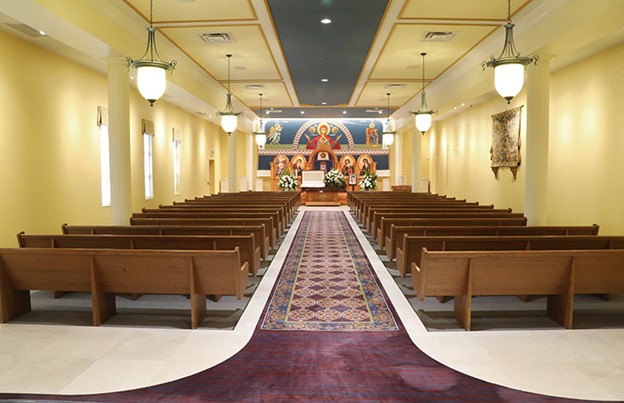
History
 The chapel is named after the late Mayor of Toronto, Ralph C. Day (1898-1976), who was also the grandfather of our current Executive Director, Glen L. Day. Ralph Day was a funeral director by trade, and opened up the Ralph Day Funeral Home on Danforth Ave., Toronto. In order to honour the memory of him as well as that of his family and their funeral home, this chapel has been named after him.
The chapel is named after the late Mayor of Toronto, Ralph C. Day (1898-1976), who was also the grandfather of our current Executive Director, Glen L. Day. Ralph Day was a funeral director by trade, and opened up the Ralph Day Funeral Home on Danforth Ave., Toronto. In order to honour the memory of him as well as that of his family and their funeral home, this chapel has been named after him.
Artwork
This chapel is dedicated to Christian visitations and services, specifically to those of the Orthodox and Eastern Christian tradition(s). The iconostasis is perhaps the first thing you will notice upon entry. The purpose of the iconostasis in a church is to separate the sanctuary from the rest of the church. In the Ralph Day Chapel, its purpose is to provide the church-like environment for visitations and services.
We commissioned Domna Papadopoulou, a renowned artist to create to the Glory of God the mural above and in the centre of the iconostasis. The centre arch mural depicts all of the important furnishings of the sanctuary of an orthodox church.
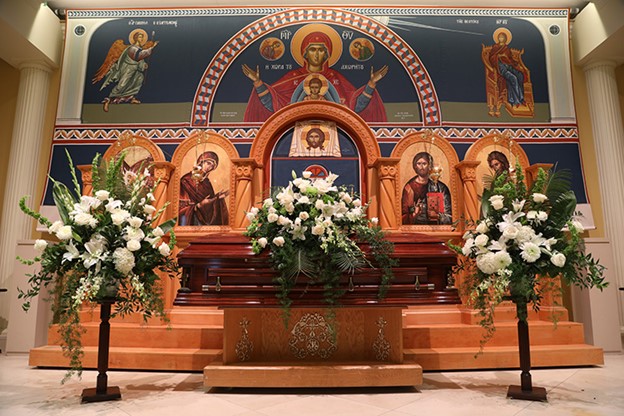
Similarly, the mural above depicts a dome-like visual of what is traditionally above the sanctuary. The centre icon is of the Theotokos (or Mother of God).
The Iconostasis
The most distinguishing feature of this chapel is the hand carved Orthodox iconostasis, something that is unique to the Orthodox and Eastern Rites of Christianity. This particular iconostasis bears in total five icons. In the centre of it is a window to the Eucharist, so to speak. Usually in the main arch one would find a gate or doors (sometimes known as the “holy doors” or the “royal doors”), from which the priest would emerge to celebrate the divine liturgy, going in between the sanctuary and main church. Given, though, that this iconostasis is not in a church, but gives the semblance of one being in a church, the centre arch provides us with a view of what one would find should they be in a church. Namely, the Altar and the Eucahrist. Above, we can see an icon of the face of Jesus - on a veil, such as that used by St. Veronica to wipe Jesus’ face on his way to his own death - giving us yet a further provision of where the Eucahrist and the Altar would lie in the Sanctuary.

This “window” was not there merely for filling in the space, though. There lies also a connection to life and death as well, as all of Heritage’s artwork has. Christians will certainly know and recognize the great sacrificial importance of the Eucharist, the Body of Christ himself. We know, for instance, that Jesus broke bread and shared wine with his Apostles on the night before he died, asking them (and each of us) to do the same in his memory. In doing so he said that these were offered for the forgiveness of sins. Again, in the Gospels Jesus says that if anyone eats of his Bread - the Bread of life - will not die, but live (cfr. John 6:50-51).
This teaching of the Eucharist in the Orthodox and Catholic traditions translates into a belief in the real, physical presence of Jesus in the Eucharistic Bread of the Altar. As such, in this window, Christ is quite literally depicted as a child lying in the liturgical Asterisk or Star-cover, where the Eucharist would be placed during the Divine Liturgy (among the other elements used for the liturgy), as if he were lying in the manger of Bethlehem at his birth, and yet waiting to be sacrificed on the Altar as he was on Calvary at his death.
On the immediate left (our right) of the iconostasis’ central arch is an icon of Jesus, carrying with him the Gospels. On the immediate right of the icon (our left) is Mary, his Mother. Beside Jesus is an icon of St. John the Baptist - his precursor - who was considered by Jesus to be one of the greatest persons to ever live (cfr. Matthew 11:11). Beside that of Mary is an icon of the Descent of Christ into Hades (see pg. 5), a central Christian belief. Lamps are also hung on the iconostasis, as a liturgical element that usually accompanies what is seen on any given iconostasis in a church.
The iconostasis is a trademark fixture in this chapel. Families oftentimes choose this chapel for the iconostasis alone, as it offers the church-like atmosphere of faith and comfort unlike any other.
The Theotokos
At the back of the iconostasis there is a large icon of Mary, the Mother of God - or Theotokos - which itself, like the centre arch of the iconostasis, gives the semblance of the inner dome of a church. In the centre of this icon is Mary and the Child Jesus, flanked by two angels. The most important inscription that likewise flanks Mary is ΜΠ ΘY, and is short for “Μητερ Θεου”, which means “The Mother/Bearer of God”. On either side of the image there is a whole different scene taking place: that of the Annunciation. As such, there are two smaller figures present on either side of the main image of Mary.

The figure on the right is Mary once again, seated and receiving the Holy Spirit, in the form of a heavenly ray. On the opposite side is the figure of St. Gabriel the Archangel, bringing to her the “good news of great joy” that is the birth of the saviour. This perhaps can be linked to the manger-like Child Jesus in the central arch of the iconostasis. Or perhaps it can allude to the Christian mystery of rebirth, and newness of life in death. The announcement of the birth of the child whose death will bring us life is a quite fitting fixture in the grand scheme of spirituality in the context of death and eternal life.
This piece can be removed from the chapel should the family so desire. It is, though, a much beloved image by Christians of all denominations, and extends further the atmosphere of a church for viewings and services in the Ralph Day Chapel.